Low Light Hanging Plants for Indoor include Spider Plant, Golden Pothos, Boston Fern, and ZZ Plant. These plants require minimal sunlight and are perfect for adding greenery to indoor spaces with limited natural light.
They are low maintenance and can survive without direct sunlight, making them ideal for beginners or those with busy schedules. With their ability to purify the air and create a calming atmosphere, these plants are a great addition to any indoor space.
Enjoy the benefits of having indoor plants without the need for direct sunlight by choosing these low light hanging plants.
Best Low Light Hanging Plants for Indoor
When it comes to indoor plants, finding the right ones for low light conditions can be a challenge. However, several beautiful and easy-to-care-for options can thrive in these environments. In this article, we’ll explore some of the best indoor hanging plants for low light, including Pothos, Spider Plant, Philodendron, and ZZ Plant.
Pothos
Pothos is one of the most popular indoor hanging plants for low light. With its vibrant green leaves and cascading growth habit, it adds a touch of nature to any room. Pothos is known for its ability to purify the air, making it a perfect addition to your living space. This low-maintenance plant can survive in a variety of light conditions, including low light. It requires minimal watering and can even tolerate some neglect.
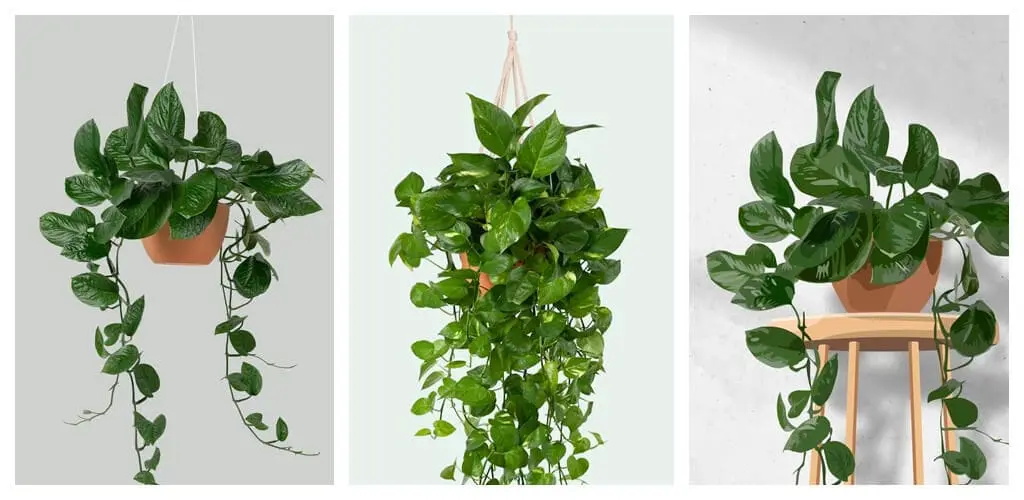
Spider Plant
The Spider Plant is another great choice for indoor hanging plants in low light conditions. It has long, arching leaves with white stripes that add a touch of elegance to any room. The Spider Plant is incredibly adaptable and can tolerate low light, making it an excellent choice for those hard-to-reach corners. It also helps in purifying the air and is pet-friendly, making it suitable for households with furry friends.
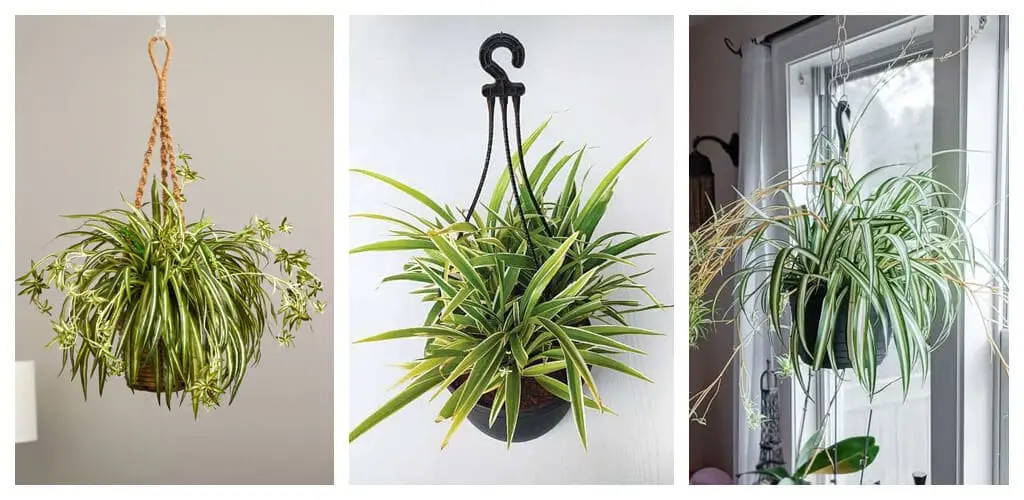
Philodendron
Philodendron is a versatile and low light friendly indoor hanging plant. With its heart-shaped leaves and trailing vines, it adds a touch of beauty to any space. Philodendrons are known for their resilience and adaptability, thriving even in low-light conditions. They require minimal watering and can tolerate some neglect, making them an excellent choice for busy individuals.
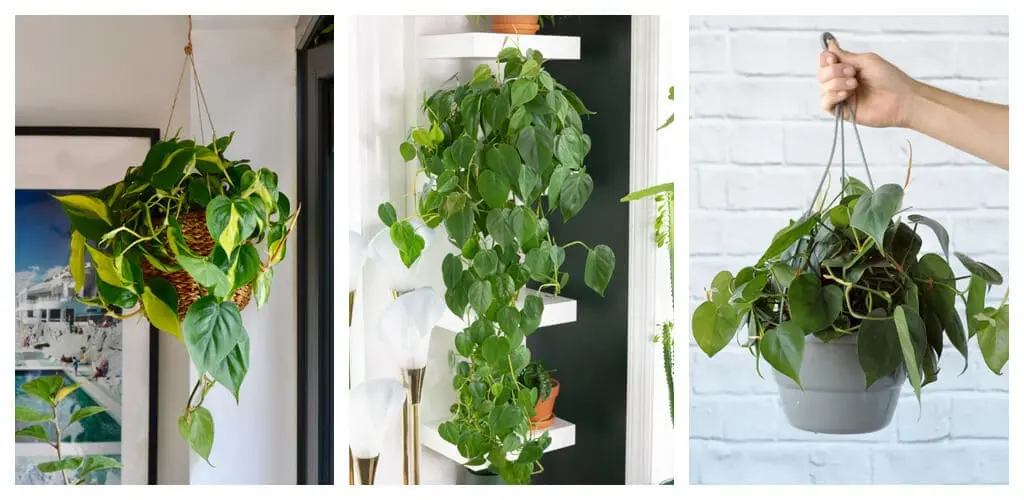
Zz Plant
The ZZ Plant is a true survivor when it comes to low-light conditions. Its glossy, dark green leaves can brighten up any room, even without direct sunlight. The ZZ Plant is known for its ability to tolerate neglect and can survive in low-light environments with minimal watering. It is an ideal choice for those who are new to indoor gardening or have a busy lifestyle.
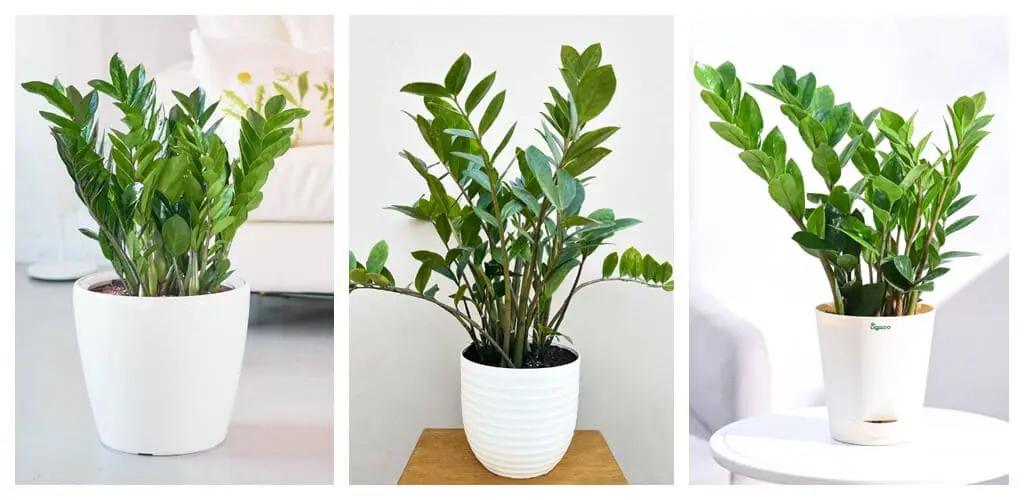
In conclusion, when it comes to indoor hanging plants for low light, Pothos, Spider Plant, Philodendron, and ZZ Plant are some of the best options. These plants not only add beauty to any space but also thrive in low-light conditions with minimal care. So, if you’re looking to bring some greenery into your home, consider these low light friendly plants and enjoy the benefits they bring.
Related Post: Best 7 Tips to Keep Birds from Eating Grass Seed
Related Post: 5 Tips for Growing Tomatoes in Buckets
Factors To Consider For Low Light Conditions
When it comes to choosing indoor hanging plants for low light conditions, there are several factors to consider. Look for plants that thrive in low light such as pothos, spider plants, and philodendrons. Additionally, consider their watering needs and make sure to place them in areas where they can receive indirect light.
Factors to Consider for Low Light Conditions When it comes to choosing indoor hanging plants for low light conditions, there are a few important factors to consider. These factors will ensure that your plants not only survive but thrive in areas with minimal natural light.
Light Requirements
The first factor to consider is the light requirements of the plants. While low light conditions generally do not provide ample sunlight, it is still crucial to choose plants that can adapt to these conditions. Some great options for low light hanging plants include Syngonium ‘Red Arrow’, Monstera adansonii ‘Monkey Mask’, and Philodendron Heart Leaf ‘Variegated’.
Watering Needs
Watering needs are another significant aspect to consider for indoor hanging plants in low light conditions. Since these plants will receive less sunlight, they are not able to photosynthesize as much and, therefore, have reduced water needs. Overwatering can lead to root rot and other plant health issues. Thus, it is essential to allow the soil to dry out partially between waterings. Golden Pothos, Spider Plant, and Monstera Siltepecana are some low light hanging plants that have lower watering needs.
Soil Type
The type of soil used for low light hanging plants is also critical for their healthy growth. A well-draining soil mix is recommended to prevent waterlogging and root rot. A mix of peat moss, perlite, and regular potting soil works well for most low light hanging plants. However, it is important to adjust the soil type as per the specific needs of the chosen plants. Boston Fern, English Ivy, and ZZ Plant are a few examples of low light hanging plants that prefer a well-draining soil mix. In conclusion, when choosing indoor hanging plants for low light conditions, consider the light requirements, watering needs, and soil type. By carefully considering these factors, you can ensure that your low light hanging plants not only survive but thrive and add beauty to your indoor space.
Care Tips For Low Light Hanging Plants
Indoor hanging plants are a great way to bring life and greenery into your home, even in low light conditions. These plants not only add beauty to your space but also help purify the air and improve the overall ambiance. However, caring for indoor hanging plants in low light requires some special attention. In this article, we will discuss some essential care tips to ensure the health and growth of your low light hanging plants.
Choosing The Right Location
When it comes to low light hanging plants, choosing the right location is crucial for their survival. Place your plants near windows with filtered light or in areas that receive partial shade throughout the day. Avoid placing them in direct sunlight as it can burn the delicate leaves. It’s also important to consider the specific light requirements of each plant species and choose a location accordingly.
Proper Watering
Tip: Proper watering techniques are vital for the health of your low light hanging plants. Overwatering or underwatering can lead to root rot or dehydration, respectively. Here are some guidelines to ensure you water your plants correctly:
- Check the soil moisture level before watering. Insert your finger into the soil up to the first knuckle. If the top layer feels dry, it’s time to water your plant.
- Use room-temperature water and pour it evenly over the soil until it drains out from the bottom of the pot.
- Ensure proper drainage by using pots with drainage holes and avoiding excessive watering.
- Observe your plants regularly and adjust the watering frequency according to their specific needs.
Fertilizing Techniques
Note: Fertilizing your low light hanging plants is essential to provide them with the necessary nutrients for healthy growth. Here are some fertilizing techniques to follow:
- Choose a balanced, water-soluble fertilizer specifically formulated for indoor plants.
- Dilute the fertilizer according to the instructions on the package.
- Apply the fertilizer once a month during the growing season (spring and summer) and reduce the frequency during the dormant period (fall and winter).
- Avoid over-fertilizing, as it can lead to salt build-up in the soil and damage the plant’s roots.
By following these care tips, you can ensure the health and growth of your indoor hanging plants in low light conditions. Remember to choose the right location, water your plants properly, and fertilize them regularly. With the proper care, your low light hanging plants will thrive and bring cheer to your indoor space.
Common Mistakes To Avoid
If you are a plant lover looking to bring the beauty of nature indoors, then indoor hanging plants are a great choice, especially for low light areas. However, it’s important to be aware of some common mistakes that can negatively impact the health and growth of your plants. By avoiding these mistakes, you can ensure that your indoor hanging plants thrive and add a touch of green freshness to your space.
Overwatering
Overwatering is a mistake that many plant enthusiasts make, and it can be detrimental to the health of indoor hanging plants. These plants generally require less water than their outdoor counterparts, as their root systems have limited access to sunlight. Therefore, it’s crucial to resist the temptation to overwater.
Overwatering can lead to root rot, which can cause the plant to wilt, turn yellow, and eventually die. To prevent this, it’s important to check the moisture level of the soil before watering. Stick your finger about an inch into the soil; if it feels dry, it’s time to water. If it still feels slightly moist, hold off on watering for a few more days.
Neglecting To Clean Leaves
Cleaning the leaves of your indoor hanging plants is an often overlooked task, but it’s essential for their overall health and appearance. Dust and debris can accumulate on the leaves, blocking sunlight and hindering the plant’s ability to photosynthesize.
To clean the leaves, simply wipe them gently with a damp cloth or sponge. This will remove any dust or dirt and allow the leaves to breathe properly. Additionally, cleaning the leaves helps prevent pests like spider mites from infesting your plants, keeping them healthy and pest-free.
Using The Wrong Potting Mix
The choice of potting mix is crucial for the well-being of your indoor hanging plants. Using the wrong mix can lead to drainage issues, root suffocation, and poor nutrient uptake.
When choosing a potting mix for your low light indoor hanging plants, look for mixes specifically formulated for houseplants. These mixes are typically lightweight, well-draining, and contain organic matter to provide the necessary nutrients.
Avoid using heavy garden soil or soil from your garden as it can retain too much moisture, leading to root rot. Additionally, avoid using containers without drainage holes, as this can also contribute to waterlogging and suffocation of the roots.
By following these tips to avoid overwatering, cleaning the leaves regularly, and using the right potting mix, you can ensure that your indoor hanging plants thrive even in low light conditions. These simple steps will keep your plants healthy, attractive, and a source of joy in your indoor space.
Related Post : Indoor Plant Soil Secrets 2024
Creative Ideas For Displaying Low Light Hanging Plants
Discover creative ideas for displaying indoor hanging plants in low light conditions. From utilizing macrame plant hangers to creating a hanging plant wall, these unique displays will add a touch of greenery to any space while thriving in low light environments.
Macrame Hangers
If you’re looking to add a bohemian touch to your indoor space, macrame hangers are a perfect choice for displaying your low-light hanging plants. These intricate and beautiful hangers are made from knotted cords, adding a touch of artistic flair to any room.
Diy Plant Shelves
If you’re feeling crafty, creating your DIY plant shelves is a fantastic way to display your indoor hanging plants in a unique and personalized way. Utilize unused wooden crates, repurposed ladder steps, or even floating shelves to create a stunning plant display that will be the envy of all.
Wall-mounted Planters
Wall-mounted planters are not only space-efficient but also provide a chic and modern way to showcase your low-light indoor hanging plants. Choose sleek, minimalist designs or mix and match different styles to create a visually appealing arrangement on your walls. Whether you opt for individual planters or a hanging wall grid system, these planters will transform any blank wall into a green oasis.
Faqs About Low Light Hanging Plants for Indoor
Curious about growing indoor hanging plants in low light conditions? Here are some frequently asked questions to help you understand how to care for your plants in low light environments.
How Do I Know If My Plant Is Getting Enough Light?
Ensuring that your indoor hanging plants receive adequate light is crucial for their growth and health. Here are some simple ways to determine if your plant is getting enough light:
- Observe the plant’s leaves – if they appear pale or yellow, it could indicate that the plant is not getting enough light.
- Check the direction and intensity of the light source – if the plant is positioned away from natural light, you may need to supplement it with artificial lighting.
- Consider the plant’s growth rate – slow growth or leggy stems can be signs of insufficient light.
Can I Grow Multiple Plants In One Hanging Basket?
Yes, you can grow multiple plants in one hanging basket, but there are a few things to keep in mind:
- Choose plants that have similar light and water requirements to ensure they thrive together.
- Consider the size of the basket and the mature size of each plant – overcrowding can lead to competition for light, water, and nutrients.
- Regularly monitor the condition of the plants and make adjustments as needed, such as trimming back certain plants to maintain a balanced appearance.
Caring for indoor hanging plants in low light is a rewarding experience. By understanding how to assess light levels and accommodate multiple plants in one hanging basket, you can create a lush and vibrant indoor garden even in the absence of ample natural light.
Frequently Asked Questions for Low Light Hanging Plants for Indoor
What Is The Best Low Light Indoor Hanging Plant?
The best low light indoor hanging plants include Golden Pothos, Epipremnum aureum, Philodendron Brasil, Scindapsus Silver Satin, Philodendron Hartleyi, Syngonium, Cebu Blue Pothos, Philodendron Micans, Pothos Pictus, and String of Bananas. These plants thrive in low light conditions and are perfect for hanging indoors.
What Hanging Plant Doesn’t Need A Lot Of Light?
Some hanging plants that don’t need a lot of light include the Golden Pothos, Epipremnum Aureum, Philodendron Brasil, and Scindapsus Silver Satin. These plants are great for indoor spaces with low light conditions.
What Indoor Plant Needs The Least Amount Of Light?
The ZZ Plant needs the least amount of light. It can survive without natural light and even neglect from watering.
Are There Any Plants That Don’t Require Sunlight?
Some plants that don’t require sunlight are: Bird’s Nest Fern, Boston Fern, Spider Plant, English Ivy, Golden Pothos, Heartleaf Philodendron, Monstera Adansonii, and Maidenhair Fern. These plants can thrive in low light conditions and are perfect for indoor spaces.
What Are The Best Low Light Indoor Hanging Plants?
Some of the best low-light indoor hanging plants are Syngonium ‘Red Arrow’, Monstera adansonii ‘Monkey Mask’, Philodendron Heart Leaf ‘Variegated’, Tradescantia ‘Quick Silver’, Hoya pubicalyx ‘Royal Hawaiian’, String of Hearts or ‘Ceropegia woodii’, Sedum morganianum or ‘Donkey’s Tail’, and Monstera Siltepecana or ‘El Salvador’.
Conclusion
Finding the perfect indoor hanging plants for low light conditions is not impossible. From the Syngonium ‘Red Arrow’ to the Monstera Siltepecana, there are plenty of options that can thrive without direct sunlight. Some other options worth considering are the ZZ Plant and the Maidenhair Fern.
These plants not only require minimal light but also add beauty and freshness to any indoor space. So, if you’re looking to brighten up your home or office with low light hanging plants, give these options a try!

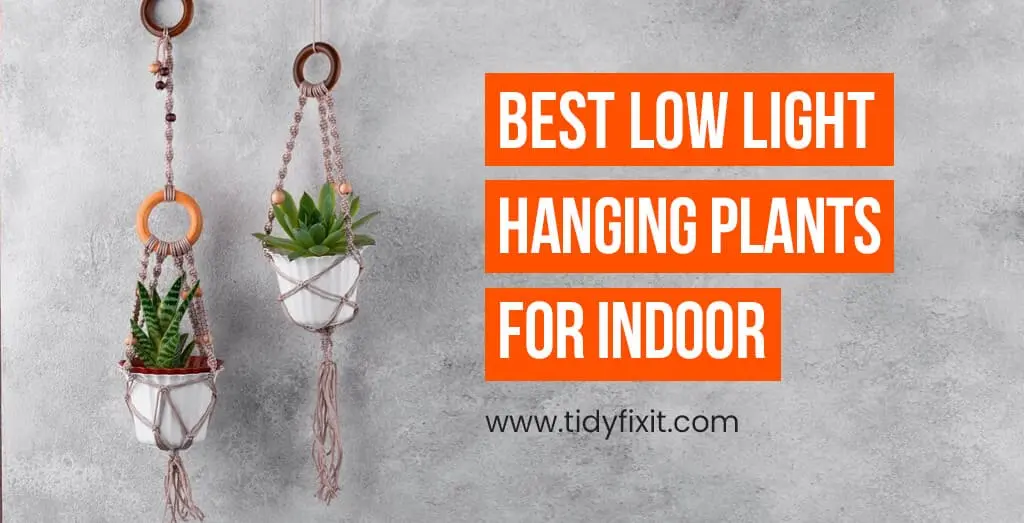



Pingback: How to Clean Monstera Leaves: 7 Best Tips to Get Shiny Leaves - Tidyfixit